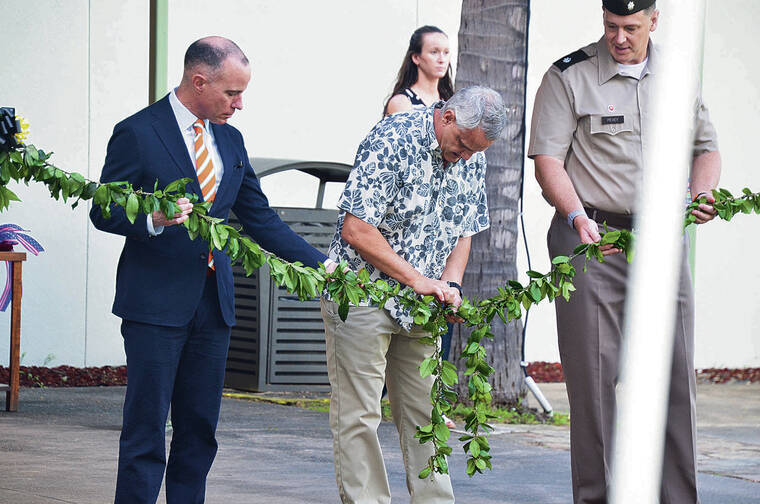U.S. Army Museum of Hawaii reopens after upgrade

KEVIN KNODELL / KKNODELL@STARADVERTISER.COM
Executive Director of U.S. Army Center of Military History Charles Bowery, left, U.S. Army Museum of Hawaii Director Kevin Field and Lt. Col. Ryan Pevey, commander, U.S. Army Corps of Engineers Honolulu District, reopened the museum at Fort DeRussy during a ceremony Monday.
The U.S. Army Museum of Hawaii at Fort DeRussy reopened Monday morning with a ribbon-cutting ceremony in Waikiki.
For the past year the Army Corps of Engineers has been upgrading its heating, ventilation and air- conditioning system, museum Director Nevin Field said. Although the execution of the HVAC project was confined to one year, it will have been six years to the month since the project was formally initiated with U.S. Army Garrison Hawaii, Directorate of Public Works.
“Much has happened during this period, so our team is very excited to showcase one of the Army’s flagship museums to the visiting public once again,” Field said.
The Army said its Waikiki museum is the service’s third most visited museum, behind the National Museum of the United States Army at Fort Belvoir, Va. and the National Infantry Museum in Columbus, Ga. First established in 1976, the museum is housed inside historic Battery Randolph, a former coast artillery fort built in 1911.
Charles Bowery, executive director of the U.S. Army Center of Military History, flew in for the reopening and told attendees that for visitors the museum offers a chance “to experience and understand a part of our nation’s history that for a mainlander is frequently glossed over.”
“When we tell the story of the U.S. Army, particularly the 20th century in the era of the world wars, we tend to focus on that other theater in Europe,” he said. “We sometimes lose or ignore the Army’s tremendous presence in the Pacific Theater — sacrifices by millions of Americans in this region of the world in the 20th century.”
Don't miss out on what's happening!
Stay in touch with breaking news, as it happens, conveniently in your email inbox. It's FREE!
The museum includes exhibits on Hawaiian warfare and weaponry during Kamehameha the Great’s campaigns to unify the islands, U.S. Army Coastal Artillery in Hawaii, Hawaii’s role in American strategy during the Spanish American War, the world wars and wars in Korea and Vietnam, as well as on the Hawaii-born nisei soldiers of the Army’s 442nd Regimental Combat Team who fought in Europe.




